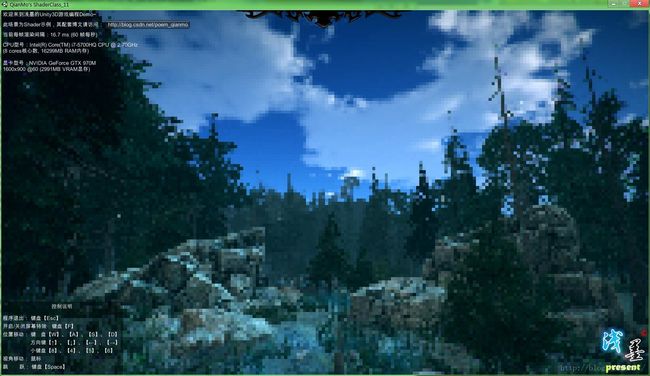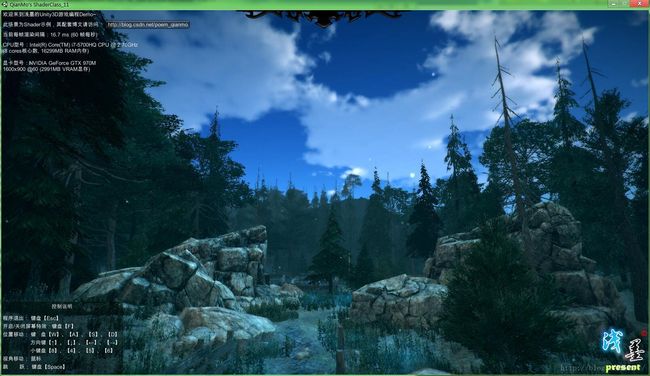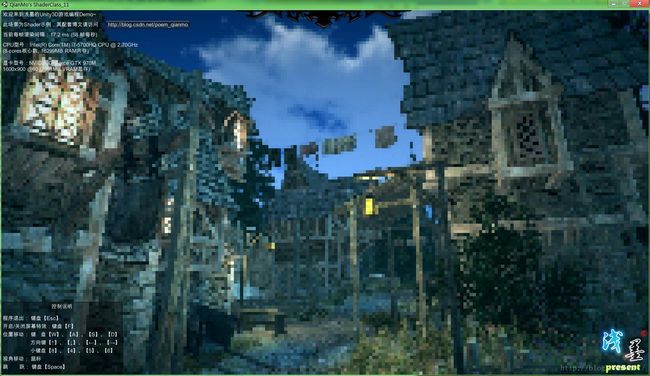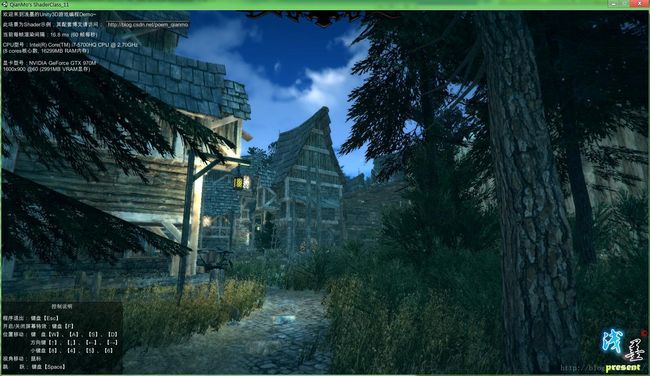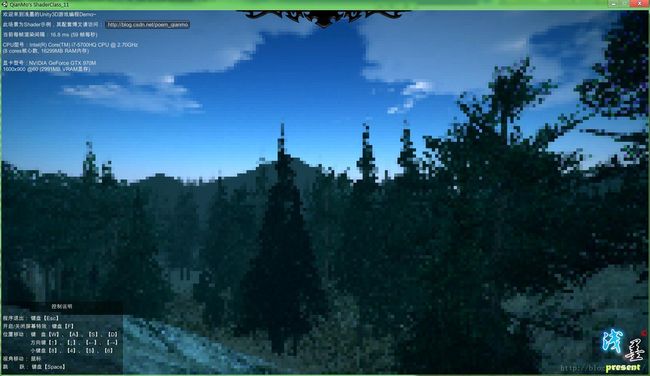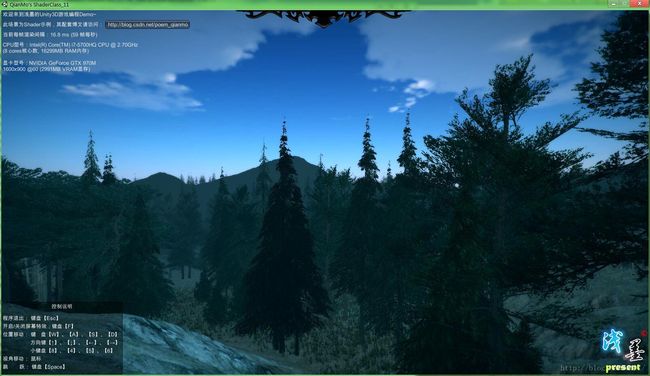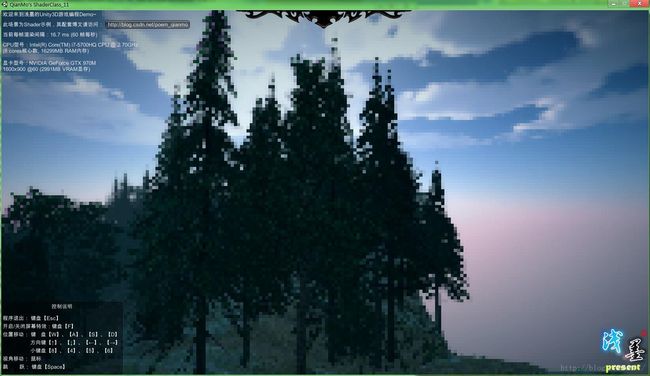图依然是贴这两张。文章末尾有更多的运行截图,并提供了源工程的下载。先放出可运行的exe下载,如下:
【可运行的本文配套exe游戏场景请点击这里下载】
提示:在此游戏场景中按F键可以开关屏幕特效。
一、关于BRDF(双向反射分布函数)
本次源码剖析有涉及BRDF的相关内容,这边简单提一下。
双向反射分布函数(Bidirectional ReflectanceDistribution Function,BRDF)用来定义给定入射方向上的辐射照度(irradiance)如何影响给定出射方向上的辐射率(radiance)。更笼统地说,它描述了入射光线经过某个表面反射后如何在各个出射方向上分布——这可以是从理想镜面反射到漫反射、各向同性(isotropic)或者各向异性(anisotropic)的各种反射。
BRDF作为图形学中比较常见的一个知识点,这边暂时不多讲,因为随便拿一本图形学相关的书都可以看到他的身影。这边给出一些参考的链接,大家有需要可以深入了解:
1. 如何正确理解 BRDF (双向反射分布函数)? - 计算机 - 知乎
2.图形学理论知识:BRDF 双向反射分布函数
3. An Introduction to BRDF-based Lighting –Nvidia
二、续Standard Shader中正向基础渲染通道源码分析
此部分接上文《【浅墨Unity3D Shader编程】之十 深入理解Unity5中的Standard Shader(二)&屏幕油画特效的实现》的第二部分“Standard Shader中正向基础渲染通道源码分析“。
上文中分析了Standard Shader中正向基础渲染通道的源码,刚好分析完了顶点着色函数vertForwardBase,本文中将对片段着色函数fragForwardBase 进行说明。分析完之后,也就结束了这一系列长得稍微有些离谱的Standard Shader正向基础渲染通道的源码分析。
OK,开始吧,先上注释好的片段着色函数fragForwardBase的代码,位于UnityStandardCore.cginc中:
//----------------------------------------【fragForwardBase函数】-------------------------------------------
// 用途:正向渲染基础通道的片段着色函数
// 输入:VertexOutputForwardBase结构体
// 输出:一个half4类型的颜色值
//------------------------------------------------------------------------------------------------------------------
half4 fragForwardBase (VertexOutputForwardBase i) : SV_Target
{
//定义并初始化类型为FragmentCommonData的变量s
FRAGMENT_SETUP(s)
//若定义了UNITY_OPTIMIZE_TEXCUBELOD,则由输入的顶点参数来设置反射光方向向量
#if UNITY_OPTIMIZE_TEXCUBELOD
s.reflUVW = i.reflUVW;
#endif
//设置主光照
UnityLight mainLight = MainLight (s.normalWorld);
//设置阴影的衰减系数
half atten = SHADOW_ATTENUATION(i);
//计算全局光照
half occlusion = Occlusion(i.tex.xy);
UnityGI gi = FragmentGI (s, occlusion, i.ambientOrLightmapUV, atten, mainLight);
//加上BRDF-基于物理的光照
half4 c = UNITY_BRDF_PBS (s.diffColor, s.specColor, s.oneMinusReflectivity, s.oneMinusRoughness, s.normalWorld, -s.eyeVec, gi.light, gi.indirect);
//加上BRDF-全局光照
c.rgb += UNITY_BRDF_GI (s.diffColor, s.specColor, s.oneMinusReflectivity, s.oneMinusRoughness, s.normalWorld, -s.eyeVec, occlusion, gi);
//加上自发光
c.rgb += Emission(i.tex.xy);
//设置雾效
UNITY_APPLY_FOG(i.fogCoord, c.rgb);
//返回最终的颜色
return OutputForward (c, s.alpha);
}
依然是老规矩,把上面代码中新接触到的相关内容进行下分条讲解。
1. FRAGMENT_SETUP(x)宏
FRAGMENT_SETUP(x)宏定义于UnityStandardCore.cginc头文件中,其作用其实就是用FragmentSetup函数初始化括号中的x变量。
#define FRAGMENT_SETUP(x) FragmentCommonData x = \
FragmentSetup(i.tex, i.eyeVec, IN_VIEWDIR4PARALLAX(i), i.tangentToWorldAndParallax, IN_WORLDPOS(i));
调用此宏,也就是表示写了如下的代码,定义了一个x变量:
FragmentCommonData x =FragmentSetup(i.tex, i.eyeVec, IN_VIEWDIR4PARALLAX(i), i.tangentToWorldAndParallax, IN_WORLDPOS(i));
其中FragmentSetup函数也定义于UnityStandardCore.cginc头文件中,用于填充一个FragmentCommonData结构体并于返回值中返回,也就是进行片段函数相关参数的初始化,相关代码如下:
//函数FragmentSetup:填充一个FragmentCommonData结构体并于返回值中返回,进行片段函数相关参数的初始化
inline FragmentCommonData FragmentSetup (float4 i_tex, half3 i_eyeVec, half3 i_viewDirForParallax, half4 tangentToWorld[3], half3 i_posWorld)
{
i_tex = Parallax(i_tex, i_viewDirForParallax);
half alpha = Alpha(i_tex.xy);
#if defined(_ALPHATEST_ON)
clip (alpha - _Cutoff);
#endif
FragmentCommonData o = UNITY_SETUP_BRDF_INPUT (i_tex);
o.normalWorld = PerPixelWorldNormal(i_tex, tangentToWorld);
o.eyeVec = NormalizePerPixelNormal(i_eyeVec);
o.posWorld = i_posWorld;
// NOTE: shader relies on pre-multiply alpha-blend (_SrcBlend = One, _DstBlend = OneMinusSrcAlpha)
o.diffColor = PreMultiplyAlpha (o.diffColor, alpha, o.oneMinusReflectivity, /*out*/ o.alpha);
return o;
}
其中的FragmentCommonData结构体也是定义于UnityStandardCore.cginc头文件中:
//FragmentCommonData结构体:存放片段着色常用变量
struct FragmentCommonData
{
half3 diffColor, specColor;//漫反射颜色;镜面反射颜色
// Note: oneMinusRoughness & oneMinusReflectivity for optimization purposes, mostly for DX9 SM2.0 level.
// Most of the math is being done on these (1-x) values, and that saves a few precious ALU slots.
half oneMinusReflectivity, oneMinusRoughness;//1减去反射率;1减去粗糙度
half3 normalWorld, eyeVec, posWorld;//世界空间中的法线向量坐标;视角向量坐标;在世界坐标中的位置坐标
half alpha;//透明度
#if UNITY_OPTIMIZE_TEXCUBELOD || UNITY_STANDARD_SIMPLE
half3 reflUVW;//反射率的UVW
#endif
#if UNITY_STANDARD_SIMPLE
half3 tangentSpaceNormal;//切线空间中的法线向量
#endif
};
2. MainLight函数
MainLight函数定义于UnityStandardCore.cginc头文件中,用途是实例化一个UnityLight结构体对象,并进行相应的填充,其返回值作为主光源。相关代码如下:
// 用途:该函数为主光照函数
// 说明:实例化一个UnityLight结构体对象,并进行相应的填充
/*
//注:UnityLight结构体定义于UnityLightingCommon.cginc文件中,原型如下:
struct UnityLight
{
half3 color;
half3 dir;
half ndotl;
};
*/
//------------------------------------【函数3】MainLight函数-----------------------------------------
// 用途:该函数为主光照函数
// 说明:实例化一个UnityLight结构体对象,并进行相应的填充
//---------------------------------------------------------------------------------------------------------
UnityLight MainLight (half3 normalWorld)
{
//【1】实例化一个UnityLight的对象
UnityLight l;
//【2】填充UnityLight的各个参数
//若光照贴图选项为关,使用Unity内置变量赋值
#ifdef LIGHTMAP_OFF
//获取光源的颜色
l.color = _LightColor0.rgb;
//获取光源的方向
l.dir = _WorldSpaceLightPos0.xyz;
//获取法线与光源方向的点乘的积
l.ndotl = LambertTerm (normalWorld, l.dir);
//光照贴图选项为开,将各项值设为0
#else
l.color = half3(0.f, 0.f, 0.f);
l.ndotl = 0.f;
l.dir = half3(0.f, 0.f, 0.f);
#endif
//返回赋值完成的UnityLight结构体对象
return l;
}
3. SHADOW_ATTENUATION宏
SHADOW_ATTENUATION宏相关的代码位于AutoLight.cginc头文件中,用于实现阴影渲染相关的辅助工作,代码如下:
// ----------------
// 阴影相关工具代码 || Shadow helpers
// ----------------
// ---- 屏幕空间阴影 || Screen space shadows
#if defined (SHADOWS_SCREEN)
……
#define SHADOW_ATTENUATION(a) unitySampleShadow(a._ShadowCoord)
#endif
// ----聚光灯光源阴影 || Spot light shadows
#if defined (SHADOWS_DEPTH) && defined (SPOT)
#define SHADOW_COORDS(idx1) unityShadowCoord4 _ShadowCoord : TEXCOORD##idx1;
#define TRANSFER_SHADOW(a) a._ShadowCoord = mul (unity_World2Shadow[0], mul(_Object2World,v.vertex));
#define SHADOW_ATTENUATION(a) UnitySampleShadowmap(a._ShadowCoord)
#endif
// ----点光源阴影 || Point light shadows
#if defined (SHADOWS_CUBE)
#define SHADOW_COORDS(idx1) unityShadowCoord3 _ShadowCoord : TEXCOORD##idx1;
#define TRANSFER_SHADOW(a) a._ShadowCoord = mul(_Object2World, v.vertex).xyz - _LightPositionRange.xyz;
#define SHADOW_ATTENUATION(a) UnitySampleShadowmap(a._ShadowCoord)
#endif
// ---- 关闭阴影 || Shadows off
#if !defined (SHADOWS_SCREEN) && !defined (SHADOWS_DEPTH) && !defined (SHADOWS_CUBE)
#define SHADOW_COORDS(idx1)
#define TRANSFER_SHADOW(a)
#define SHADOW_ATTENUATION(a) 1.0
#endif
可以发现,SHADOW_ATTENUATION(a)宏除了在关闭阴影的状态是等于1以外,其他几种情况都是等价于UnitySampleShadowmap(a._ShadowCoord)函数的调用。而这里的UnitySampleShadowmap函数,定于于UnityShadowLibrary.cginc函数中。实现代码如下。
//------------------------------【UnitySampleShadowmap函数】---------------------------------
// 用途:采样阴影贴图,得到阴影衰减值
// 输入参数: float3型的阴影向量坐标vec
// 返回值:阴影衰减值
//-------------------------------------------------------------------------------------------------------
inline half UnitySampleShadowmap (float3 vec)
{
float mydist = length(vec) * _LightPositionRange.w;
mydist *= 0.97; // bias
#if defined (SHADOWS_SOFT)
float z = 1.0/128.0;
float4 shadowVals;
shadowVals.x = SampleCubeDistance (vec+float3( z, z, z));
shadowVals.y = SampleCubeDistance (vec+float3(-z,-z, z));
shadowVals.z = SampleCubeDistance (vec+float3(-z, z,-z));
shadowVals.w = SampleCubeDistance (vec+float3( z,-z,-z));
half4 shadows = (shadowVals < mydist.xxxx) ? _LightShadowData.rrrr : 1.0f;
return dot(shadows,0.25);
#else
float dist = SampleCubeDistance (vec);
return dist < mydist ? _LightShadowData.r : 1.0;
#endif
}
4. Occlusion函数
Occlusion函数用于进行全局光照的第一步。其输入参数为一个float2型的纹理坐标,而其half型的返回值将作为FragmentGI函数的一个输入参数。Occlusion函数的原型如下:
half Occlusion(float2 uv)
{
#if (SHADER_TARGET < 30)
// SM20: instruction count limitation
// SM20: simpler occlusion
return tex2D(_OcclusionMap, uv).g;
#else
half occ = tex2D(_OcclusionMap, uv).g;
return LerpOneTo (occ, _OcclusionStrength);
#endif
}
其中的LerpOneTo函数很简单,用于线性插值,输入两个值b和t,返回1+(b-1)*t,具体定义如下:
half LerpOneTo(half b, half t)
{
half oneMinusT = 1 - t;
return oneMinusT + b * t;
}
5. UnityGI结构体
UnityGI结构体是Unity中存放全局光照光源信息的结构体,定义于UnityLightingCommon.cginc头文件中,如下。
//全局光照结构体
struct UnityGI
{
UnityLight light;//定义第一个光源参数结构体,表示第一个光源
//若定义了DIRLIGHTMAP_SEPARATE(单独的方向光源光照贴图)
#ifdef DIRLIGHTMAP_SEPARATE
//若定义了LIGHTMAP_ON(打开光照贴图)
#ifdef LIGHTMAP_ON
UnityLight light2;//定义第二个光源参数结构体,表示第二个光源
#endif
//若定义了DYNAMICLIGHTMAP_ON(打开动态光照贴图)
#ifdef DYNAMICLIGHTMAP_ON
UnityLight light3;//定义第三个光源参数结构体,表示第三个光源
#endif
#endif
UnityIndirect indirect;//Unity中间接光源参数的结构体
};
其中包含了UnityLight结构体和UnityIndirect结构体,其中UnityLight结构体是Unity Shader中最基本的光照结构体,而UnityIndirect是Unity中存放间接光源信息的结构体。它们两者也定义于UnityLightingCommon.cginc头文件中,代码如下。
//Unity中光源参数的结构体
struct UnityLight
{
half3 color;//光源颜色
half3 dir;//光源方向
half ndotl; //入射光方向和当前表面法线方向的点积
};
//Unity中间接光源参数的结构体
struct UnityIndirect
{
half3 diffuse;//漫反射颜色
half3 specular;//镜面反射颜色
};
6. FragmentGI函数
FragmentGI函数是片段着色部分全局光照的处理函数,定义于UnityStandardCore.cginc头文件中。相关代码如下:
//函数:片段着色部分全局光照的处理函数
inline UnityGI FragmentGI (FragmentCommonData s, half occlusion, half4 i_ambientOrLightmapUV, half atten, UnityLight light, bool reflections)
{
//【1】实例化一个UnityGIInput的对象
UnityGIInput d;
//【2】填充此UnityGIInput对象的各个值
d.light = light;
d.worldPos = s.posWorld;
d.worldViewDir = -s.eyeVec;
d.atten = atten;
#if defined(LIGHTMAP_ON) || defined(DYNAMICLIGHTMAP_ON)
d.ambient = 0;
d.lightmapUV = i_ambientOrLightmapUV;
#else
d.ambient = i_ambientOrLightmapUV.rgb;
d.lightmapUV = 0;
#endif
d.boxMax[0] = unity_SpecCube0_BoxMax;
d.boxMin[0] = unity_SpecCube0_BoxMin;
d.probePosition[0] = unity_SpecCube0_ProbePosition;
d.probeHDR[0] = unity_SpecCube0_HDR;
d.boxMax[1] = unity_SpecCube1_BoxMax;
d.boxMin[1] = unity_SpecCube1_BoxMin;
d.probePosition[1] = unity_SpecCube1_ProbePosition;
d.probeHDR[1] = unity_SpecCube1_HDR;
//【3】根据填充好的UnityGIInput结构体对象,调用一下UnityGlobalIllumination函数
if(reflections)
{
Unity_GlossyEnvironmentData g;
g.roughness = 1 - s.oneMinusRoughness;
#if UNITY_OPTIMIZE_TEXCUBELOD || UNITY_STANDARD_SIMPLE
g.reflUVW = s.reflUVW;
#else
g.reflUVW = reflect(s.eyeVec, s.normalWorld);
#endif
return UnityGlobalIllumination (d, occlusion, s.normalWorld, g);
}
else
{
return UnityGlobalIllumination (d, occlusion, s.normalWorld);
}
}
inline UnityGI FragmentGI (FragmentCommonData s, half occlusion, half4 i_ambientOrLightmapUV, half atten, UnityLight light)
{
return FragmentGI(s, occlusion, i_ambientOrLightmapUV, atten, light, true);
}
其中的UnityGIInput结构体定义了全局光照所需要的一些函数,定义为如下:
//全局光照的输入参数结构体
struct UnityGIInput
{
UnityLight light; // 像素光源,由引擎准备并传输过来 || pixel light, sent from the engine
float3 worldPos;//世界空间中的位置坐标
half3 worldViewDir;//世界空间中的视角方向向量坐标
half atten;//衰减值
half3 ambient;//环境光颜色
half4 lightmapUV; //光照贴图的UV坐标,其中 取.xy = static lightmapUV(静态光照贴图的UV) , .zw = dynamic lightmap UV(动态光照贴图的UV)
float4 boxMax[2];//box最大值
float4 boxMin[2];//box最小值
float4 probePosition[2];//光照探针的位置
float4 probeHDR[2];//光照探针的高动态范围图像(High-Dynamic Range)
};
UnityGIInput 中还包含了UnityLight结构体,其定义和代码实现上文刚刚已经有提到过。
FragmentGI函数最终利用了UnityGlobalIllumination函数,其定义于UnityGlobalIllumination.cginc头文件中,实现如下。
inline UnityGI UnityGlobalIllumination (UnityGIInput data, half occlusion, half3 normalWorld)
{
return UnityGI_Base(data, occlusion, normalWorld);
}
此FragmentGI函数就是嵌套了一层UnityGI_Base函数,那我们继续溯源,找到UnityGI_Base函数的定义,也是位于UnityGlobalIllumination.cginc头文件中:
//UnityGI_Base函数:Unity的全局光照Base版
inline UnityGI UnityGI_Base(UnityGIInput data, half occlusion, half3 normalWorld)
{
//【1】实例化一个UnityGI类型的结构体
UnityGI o_gi;
//【2】重置此UnityGI的结构体
ResetUnityGI(o_gi);
//【3】开始逐个填充参数
#if !defined(LIGHTMAP_ON)
o_gi.light = data.light;
o_gi.light.color *= data.atten;
#endif
#if UNITY_SHOULD_SAMPLE_SH
#if UNITY_SAMPLE_FULL_SH_PER_PIXEL
half3 sh = ShadeSH9(half4(normalWorld, 1.0));
#elif (SHADER_TARGET >= 30) && !UNITY_STANDARD_SIMPLE
half3 sh = data.ambient + ShadeSH12Order(half4(normalWorld, 1.0));
#else
half3 sh = data.ambient;
#endif
o_gi.indirect.diffuse = sh;
#endif
#if defined(LIGHTMAP_ON)
// Baked lightmaps
fixed4 bakedColorTex = UNITY_SAMPLE_TEX2D(unity_Lightmap, data.lightmapUV.xy);
half3 bakedColor = DecodeLightmap(bakedColorTex);
#ifdef DIRLIGHTMAP_OFF
o_gi.indirect.diffuse = bakedColor;
#ifdef SHADOWS_SCREEN
o_gi.indirect.diffuse = MixLightmapWithRealtimeAttenuation (o_gi.indirect.diffuse, data.atten, bakedColorTex);
#endif // SHADOWS_SCREEN
#elif DIRLIGHTMAP_COMBINED
fixed4 bakedDirTex = UNITY_SAMPLE_TEX2D_SAMPLER (unity_LightmapInd, unity_Lightmap, data.lightmapUV.xy);
o_gi.indirect.diffuse = DecodeDirectionalLightmap (bakedColor, bakedDirTex, normalWorld);
#ifdef SHADOWS_SCREEN
o_gi.indirect.diffuse = MixLightmapWithRealtimeAttenuation (o_gi.indirect.diffuse, data.atten, bakedColorTex);
#endif // SHADOWS_SCREEN
#elif DIRLIGHTMAP_SEPARATE
// Left halves of both intensity and direction lightmaps store direct light; right halves - indirect.
// Direct
fixed4 bakedDirTex = UNITY_SAMPLE_TEX2D_SAMPLER(unity_LightmapInd, unity_Lightmap, data.lightmapUV.xy);
o_gi.indirect.diffuse = DecodeDirectionalSpecularLightmap (bakedColor, bakedDirTex, normalWorld, false, 0, o_gi.light);
// Indirect
half2 uvIndirect = data.lightmapUV.xy + half2(0.5, 0);
bakedColor = DecodeLightmap(UNITY_SAMPLE_TEX2D(unity_Lightmap, uvIndirect));
bakedDirTex = UNITY_SAMPLE_TEX2D_SAMPLER(unity_LightmapInd, unity_Lightmap, uvIndirect);
o_gi.indirect.diffuse += DecodeDirectionalSpecularLightmap (bakedColor, bakedDirTex, normalWorld, false, 0, o_gi.light2);
#endif
#endif
#ifdef DYNAMICLIGHTMAP_ON
// Dynamic lightmaps
fixed4 realtimeColorTex = UNITY_SAMPLE_TEX2D(unity_DynamicLightmap, data.lightmapUV.zw);
half3 realtimeColor = DecodeRealtimeLightmap (realtimeColorTex);
#ifdef DIRLIGHTMAP_OFF
o_gi.indirect.diffuse += realtimeColor;
#elif DIRLIGHTMAP_COMBINED
half4 realtimeDirTex = UNITY_SAMPLE_TEX2D_SAMPLER(unity_DynamicDirectionality, unity_DynamicLightmap, data.lightmapUV.zw);
o_gi.indirect.diffuse += DecodeDirectionalLightmap (realtimeColor, realtimeDirTex, normalWorld);
#elif DIRLIGHTMAP_SEPARATE
half4 realtimeDirTex = UNITY_SAMPLE_TEX2D_SAMPLER(unity_DynamicDirectionality, unity_DynamicLightmap, data.lightmapUV.zw);
half4 realtimeNormalTex = UNITY_SAMPLE_TEX2D_SAMPLER(unity_DynamicNormal, unity_DynamicLightmap, data.lightmapUV.zw);
o_gi.indirect.diffuse += DecodeDirectionalSpecularLightmap (realtimeColor, realtimeDirTex, normalWorld, true, realtimeNormalTex, o_gi.light3);
#endif
#endif
o_gi.indirect.diffuse *= occlusion;
//【4】返回此UnityGI类型的结构体
return o_gi;
}
不难发现,此FragmentGI函数的实现,也就是实例化一个UnityGIInput结构体对象,然后依次填充了此结构体对象的每个各个参数,最后调用一下基于UnityGI_Base函数的UnityGlobalIllumination函数而已。
7. UNITY_BRDF_PBS宏
首先,这边有一段宏,定义于UnityPBSLighting.cginc头文件中,根据不同的情况,将UNITY_BRDF_PBS宏定义为不同版本的UNITY_BRDF_PBS宏——是BRDF3_Unity_PBS、BRDF2_Unity_PBS还是BRDF1_Unity_PBS。
//-------------------------------------------------------------------------------------
// 默认使用BRDF || Default BRDF to use:
#if !defined (UNITY_BRDF_PBS) // 允许显式地在自定义着色器中重写BRDF的实现细节 || allow to explicitly override BRDF in custom shader
//满足着色目标模型的版本小于Shader Model 3.0,或者是PlayStation 2平台
#if (SHADER_TARGET < 30) || defined(SHADER_API_PSP2)
// 为小于SM3.0的着色模型回退为低保真度的BRDF版本 || Fallback to low fidelity one for pre-SM3.0
#define UNITY_BRDF_PBS BRDF3_Unity_PBS
#elif defined(SHADER_API_MOBILE)
// 为移动平台简化的BRDF版本 || Somewhat simplified for mobile
#define UNITY_BRDF_PBS BRDF2_Unity_PBS
#else
//最高特效的SM3、PC平台或者游戏主机平台的BRDF版本 || Full quality for SM3+ PC / consoles
#define UNITY_BRDF_PBS BRDF1_Unity_PBS
#endif
#endif
三种情况下,BRDF3_Unity_PBS、BRDF2_Unity_PBS、 BRDF1_Unity_PBS三个函数的参数和返回值都一样,区别仅仅是内部的实现。在这边,以BRDF1_Unity_PBS为例,讲一下参数值的含义。
half4 BRDF1_Unity_PBS (half3 diffColor,half3 specColor, half oneMinusReflectivity, half oneMinusRoughness,half3 normal,half3 viewDir,UnityLight light, UnityIndirect gi)
第一个参数,half3型的diffColor,表示漫反射颜色的值。
第二个参数,half3型的specColor,表示镜面反射颜色值。
第三个参数,half型的oneMinusReflectivity,表示1减去反射率的值。
第四个参数,half型的oneMinusRoughness,表示1减去粗糙度的值。
第五次参数,half3型的normal,表示法线的方向。
第六个参数,half3型的viewDir,表示视线的方向。
第七个参数,UnityLight型的light,表示Unity中光源参数的结构体,包含half3型的光源颜色color,half3型的光源方向dir,half型的入射光方向和当前表面法线方向的点乘的积ndotl。上文有贴出过其实现代码,都几次提到了,这边就再贴一下。
struct UnityLight
{
half3 color;//光源颜色
half3 dir;//光源方向
half ndotl; //入射光方向和当前表面法线方向的点积
};
第八个参数,UnityIndirect类型的gi ,一个包含了half3型的漫反射颜色diffuse和half3型的镜面反射颜色specular的光线反射结构体,表示间接光照信息。
struct UnityIndirect
{
half3 diffuse;//漫反射颜色
half3 specular;//镜面反射颜色
};
下面将三种版本的函数分别贴出来,它们都定义于UnityStandardBRDF.cginc头文件中。
7.1 BRDF1_Unity_PBS
//最高特效的SM3、PC平台或者游戏主机平台的BRDF版本 || Full quality for SM3+ PC / consoles
//-------------------------------------------------------------------------------------
// Note: BRDF entry points use oneMinusRoughness (aka "smoothness") and oneMinusReflectivity for optimization
// purposes, mostly for DX9 SM2.0 level. Most of the math is being done on these (1-x) values, and that saves
// a few precious ALU slots.
// Main Physically Based BRDF
// Derived from Disney work and based on Torrance-Sparrow micro-facet model
//
// BRDF = kD / pi + kS * (D * V * F) / 4
// I = BRDF * NdotL
//
// * NDF (depending on UNITY_BRDF_GGX):
// a) Normalized BlinnPhong
// b) GGX
// * Smith for Visiblity term
// * Schlick approximation for Fresnel
half4 BRDF1_Unity_PBS (half3 diffColor, half3 specColor, half oneMinusReflectivity, half oneMinusRoughness,
half3 normal, half3 viewDir,
UnityLight light, UnityIndirect gi)
{
half roughness = 1-oneMinusRoughness;
half3 halfDir = Unity_SafeNormalize (light.dir + viewDir);
half nl = light.ndotl;
half nh = BlinnTerm (normal, halfDir);
half nv = DotClamped (normal, viewDir);
half lv = DotClamped (light.dir, viewDir);
half lh = DotClamped (light.dir, halfDir);
#if UNITY_BRDF_GGX
half V = SmithGGXVisibilityTerm (nl, nv, roughness);
half D = GGXTerm (nh, roughness);
#else
half V = SmithBeckmannVisibilityTerm (nl, nv, roughness);
half D = NDFBlinnPhongNormalizedTerm (nh, RoughnessToSpecPower (roughness));
#endif
half nlPow5 = Pow5 (1-nl);
half nvPow5 = Pow5 (1-nv);
half Fd90 = 0.5 + 2 * lh * lh * roughness;
half disneyDiffuse = (1 + (Fd90-1) * nlPow5) * (1 + (Fd90-1) * nvPow5);
// HACK: theoretically we should divide by Pi diffuseTerm and not multiply specularTerm!
// BUT 1) that will make shader look significantly darker than Legacy ones
// and 2) on engine side "Non-important" lights have to be divided by Pi to in cases when they are injected into ambient SH
// NOTE: multiplication by Pi is part of single constant together with 1/4 now
half specularTerm = max(0, (V * D * nl) * unity_LightGammaCorrectionConsts_PIDiv4);// Torrance-Sparrow model, Fresnel is applied later (for optimization reasons)
half diffuseTerm = disneyDiffuse * nl;
half grazingTerm = saturate(oneMinusRoughness + (1-oneMinusReflectivity));
half3 color = diffColor * (gi.diffuse + light.color * diffuseTerm)
+ specularTerm * light.color * FresnelTerm (specColor, lh)
+ gi.specular * FresnelLerp (specColor, grazingTerm, nv);
return half4(color, 1);
}
7.2 BRDF2_Unity_PBS
12
// 为移动平台简化的BRDF版本 || Somewhat simplified for mobile
// Based on Minimalist CookTorrance BRDF
// Implementation is slightly different from original derivation: http://www.thetenthplanet.de/archives/255
//
// * BlinnPhong as NDF
// * Modified Kelemen and Szirmay-Kalos for Visibility term
// * Fresnel approximated with 1/LdotH
half4 BRDF2_Unity_PBS (half3 diffColor, half3 specColor, half oneMinusReflectivity, half oneMinusRoughness,
half3 normal, half3 viewDir,
UnityLight light, UnityIndirect gi)
{
half3 halfDir = Unity_SafeNormalize (light.dir + viewDir);
half nl = light.ndotl;
half nh = BlinnTerm (normal, halfDir);
half nv = DotClamped (normal, viewDir);
half lh = DotClamped (light.dir, halfDir);
half roughness = 1-oneMinusRoughness;
half specularPower = RoughnessToSpecPower (roughness);
// Modified with approximate Visibility function that takes roughness into account
// Original ((n+1)*N.H^n) / (8*Pi * L.H^3) didn't take into account roughness
// and produced extremely bright specular at grazing angles
// HACK: theoretically we should divide by Pi diffuseTerm and not multiply specularTerm!
// BUT 1) that will make shader look significantly darker than Legacy ones
// and 2) on engine side "Non-important" lights have to be divided by Pi to in cases when they are injected into ambient SH
// NOTE: multiplication by Pi is cancelled with Pi in denominator
half invV = lh * lh * oneMinusRoughness + roughness * roughness; // approx ModifiedKelemenVisibilityTerm(lh, 1-oneMinusRoughness);
half invF = lh;
half specular = ((specularPower + 1) * pow (nh, specularPower)) / (unity_LightGammaCorrectionConsts_8 * invV * invF + 1e-4h); // @TODO: might still need saturate(nl*specular) on Adreno/Mali
// Prevent FP16 overflow on mobiles
#if SHADER_API_GLES || SHADER_API_GLES3
specular = clamp(specular, 0.0, 100.0);
#endif
half grazingTerm = saturate(oneMinusRoughness + (1-oneMinusReflectivity));
half3 color = (diffColor + specular * specColor) * light.color * nl
+ gi.diffuse * diffColor
+ gi.specular * FresnelLerpFast (specColor, grazingTerm, nv);
return half4(color, 1);
}
7.3 BRDF3_Unity_PBS
// 为小于SM3.0的着色模型回退为低保真度的BRDF版本 || Fallback to low fidelity one for pre-SM3.0
// Old school, not microfacet based Modified Normalized Blinn-Phong BRDF
// Implementation uses Lookup texture for performance
//
// * Normalized BlinnPhong in RDF form
// * Implicit Visibility term
// * No Fresnel term
//
// TODO: specular is too weak in Linear rendering mode
half4 BRDF3_Unity_PBS (half3 diffColor, half3 specColor, half oneMinusReflectivity, half oneMinusRoughness,
half3 normal, half3 viewDir,
UnityLight light, UnityIndirect gi)
{
half3 reflDir = reflect (viewDir, normal);
half nl = light.ndotl;
half nv = DotClamped (normal, viewDir);
// Vectorize Pow4 to save instructions
half2 rlPow4AndFresnelTerm = Pow4 (half2(dot(reflDir, light.dir), 1-nv)); // use R.L instead of N.H to save couple of instructions
half rlPow4 = rlPow4AndFresnelTerm.x; // power exponent must match kHorizontalWarpExp in NHxRoughness() function in GeneratedTextures.cpp
half fresnelTerm = rlPow4AndFresnelTerm.y;
half grazingTerm = saturate(oneMinusRoughness + (1-oneMinusReflectivity));
half3 color = BRDF3_Direct(diffColor, specColor, rlPow4, oneMinusRoughness);
color *= light.color * nl;
color += BRDF3_Indirect(diffColor, specColor, gi, grazingTerm, fresnelTerm);
return half4(color, 1);
}
BRDF1_Unity_PBS函数的实现部分用到了最多的变量,最终表现效果最好,主要用于Shader Model 3.0、PC平台或者游戏主机平台。BRDF2_Unity_PBS简化了一部分计算,主要用于移动平台,而BRDF3_Unity_PBS是为Shader Model 小于3.0的着色模型提供基本版的BRDF,实现细节最为简陋。
8. UNITY_BRDF_GI宏
UNITY_BRDF_GI宏位于UnityPBSLighting.cginc头文件中,相关代码如下。
//-------------------------------------------------------------------------------------
// 从间接的方向光照贴图中进行BRDF(双向反射分布函数)的光照提取 || BRDF for lights extracted from *indirect* directional lightmaps (baked and realtime).
// 使用UNITY_BRDF_PBS从方向光源烘焙方向光照贴图, || Baked directional lightmap with *direct* light uses UNITY_BRDF_PBS.
// 若想得到更好的效果,可以使用BRDF1_Unity_PBS || For better quality change to BRDF1_Unity_PBS.
// SM2.0中的非方向光照贴图|| No directional lightmaps in SM2.0.
//若没有定义UNITY_BRDF_PBS_LIGHTMAP_INDIRECT宏
#if !defined(UNITY_BRDF_PBS_LIGHTMAP_INDIRECT)
//定义UNITY_BRDF_PBS_LIGHTMAP_INDIRECT = BRDF2_Unity_PBS
#define UNITY_BRDF_PBS_LIGHTMAP_INDIRECT BRDF2_Unity_PBS
#endif
//若没有定义UNITY_BRDF_GI宏
#if !defined (UNITY_BRDF_GI)
//定义UNITY_BRDF_GI = BRDF_Unity_Indirect
#define UNITY_BRDF_GI BRDF_Unity_Indirect
#endif
上面这段代码中关于UNITY_BRDF_GI宏的地方,就是说若没有定义UNITY_BRDF_GI宏,就定义一个UNITY_BRDF_GI宏等价于BRDF_Unity_Indirect。这边的BRDF_Unity_Indirect是一个函数名,就紧紧跟在上面这段宏代码的后面:
//间接光照的BRDF
inline half3 BRDF_Unity_Indirect (half3 baseColor, half3 specColor, half oneMinusReflectivity, half oneMinusRoughness, half3 normal, half3 viewDir, half occlusion, UnityGI gi)
{
half3 c = 0;
#if defined(DIRLIGHTMAP_SEPARATE)
gi.indirect.diffuse = 0;
gi.indirect.specular = 0;
#ifdef LIGHTMAP_ON
c += UNITY_BRDF_PBS_LIGHTMAP_INDIRECT (baseColor, specColor, oneMinusReflectivity, oneMinusRoughness, normal, viewDir, gi.light2, gi.indirect).rgb * occlusion;
#endif
#ifdef DYNAMICLIGHTMAP_ON
c += UNITY_BRDF_PBS_LIGHTMAP_INDIRECT (baseColor, specColor, oneMinusReflectivity, oneMinusRoughness, normal, viewDir, gi.light3, gi.indirect).rgb * occlusion;
#endif
#endif
return c;
}
关于此段代码,BRDF_Unity_Indirect 函数的核心部分其实就是在调用UNITY_BRDF_PBS_LIGHTMAP_INDIRECT,而上文的宏有交代过,UNITY_BRDF_PBS_LIGHTMAP_INDIRECT宏等价于 BRDF2_Unity_PBS。而BRDF2_Unity_PBS函数,其定义于UnityStandardBRDF.cginc中,是为移动平台简化的BRDF版本,这个上文刚刚提到过,这边就不多交代。
9.Emission函数
Emission函数定于于UnityStandardInput.cginc头文件中,根据指定的自发光光照贴图,利用tex2D函数,对输入的纹理进行光照贴图的采样,相关代码如下:
//---------------------------------------【Emission函数】-----------------------------------------
// 用途:根据指定的自发光光照贴图,利用tex2D函数,对输入的纹理进行光照贴图的采样
// 输入参数:float2型的纹理坐标
// 输出参数:经过将自发光纹理和输入纹理进行tex2D采样得到的half3型的自发光颜色
//-----------------------------------------------------------------------------------------------
half3 Emission(float2 uv)
{
#ifndef _EMISSION
return 0;
#else
return tex2D(_EmissionMap, uv).rgb * _EmissionColor.rgb;
#endif
}
其中用于采样的自发光贴图对应的函数定义于UnityStandardInput.cginc头文件的一开始部分。
sampler2D _EmissionMap;
这边这句代码其实是相当于在CGPROGRAM中的顶点和片段着色函数之前,对这个变量进行声明,以便于CG语言块中使用的时候,能识别到他的含义。因为在Standard.shader源码的一开始,Properties块也就是属性值声明部分,对其进行了属性的声明:
//自发光纹理图
_EmissionMap("Emission", 2D) = "white" {}
10.UNITY_APPLY_FOG宏
UNITY_APPLY_FOG宏相关的一些代码用于雾效的启用与否的辅助工作,定义于UnityCG.cginc头文件中,这边贴出注释好的代码即可。
//UNITY_FOG_LERP_COLOR宏的定义
#define UNITY_FOG_LERP_COLOR(col,fogCol,fogFac) col.rgb = lerp((fogCol).rgb, (col).rgb, saturate(fogFac))
//【1】若已经定义了FOG_LINEAR、FOG_EXP、FOG_EXP2宏三者至少之一,便可以进行到此#if实现部分
#if defined(FOG_LINEAR) || defined(FOG_EXP) || defined(FOG_EXP2)
//【1-1】若满足着色目标模型的版本小于Shader Model 3.0,或者定义了SHADER_API_MOBILE宏,便可以进行到此#if实现部分
#if (SHADER_TARGET < 30) || defined(SHADER_API_MOBILE)
//移动平台和Shader Model 2.0:已经计算了每顶点的雾效因子,所以插一下值就可以了 ||mobile or SM2.0: fog factor was already calculated per-vertex, so just lerp the color
//定义 UNITY_APPLY_FOG_COLOR(coord,col,fogCol) 等价于UNITY_FOG_LERP_COLOR(col,fogCol,coord)
#define UNITY_APPLY_FOG_COLOR(coord,col,fogCol) UNITY_FOG_LERP_COLOR(col,fogCol,coord)
//【1-2】 Shader Model 3.0和PC/游戏主机平台:计算雾效因子以及进行雾颜色的插值 ||SM3.0 and PC/console: calculate fog factor and lerp fog color
#else
//定义 UNITY_APPLY_FOG_COLOR(coord,col,fogCol)等价于UNITY_CALC_FOG_FACTOR(coord); UNITY_FOG_LERP_COLOR(col,fogCol,unityFogFactor)
#define UNITY_APPLY_FOG_COLOR(coord,col,fogCol) UNITY_CALC_FOG_FACTOR(coord); UNITY_FOG_LERP_COLOR(col,fogCol,unityFogFactor)
#endif
//【2】否则,直接定义UNITY_APPLY_FOG_COLOR宏
#else
#define UNITY_APPLY_FOG_COLOR(coord,col,fogCol)
#endif
//【3】若定义了UNITY_PASS_FORWARDADD(正向附加渲染通道)宏
#ifdef UNITY_PASS_FORWARDADD
//定义UNITY_APPLY_FOG(coord,col) 等价于UNITY_APPLY_FOG_COLOR(coord,col,fixed4(0,0,0,0))
#define UNITY_APPLY_FOG(coord,col) UNITY_APPLY_FOG_COLOR(coord,col,fixed4(0,0,0,0))
//【4】否则,UNITY_APPLY_FOG(coord,col) 等价于 UNITY_APPLY_FOG_COLOR(coord,col,unity_FogColor)
#else
#define UNITY_APPLY_FOG(coord,col) UNITY_APPLY_FOG_COLOR(coord,col,unity_FogColor)
#endif
11.OutputForward函数
OutputForward函数定义于UnityStandardCore.cginc头文件中,其为正向渲染通道的输出函数。//-----------------------------【函数OutputForward】----------------------------------------------
// 用途:正向渲染通道输出函数
// 输入参数:一个half4类型的一个颜色值output,一个half型的透明度值alphaFromSurface
// 返回值:经过透明处理的half4型的输出颜色值
//-------------------------------------------------------------------------------------------------
half4 OutputForward (half4 output, half alphaFromSurface)
{
#if defined(_ALPHABLEND_ON) || defined(_ALPHAPREMULTIPLY_ON)
output.a = alphaFromSurface;
#else
UNITY_OPAQUE_ALPHA(output.a);
#endif
return output;
}
其中UNITY_OPAQUE_ALPHA宏的定义为:
#define UNITY_OPAQUE_ALPHA(outputAlpha) outputAlpha = 1.0
三、屏幕像素化特效的实现
我们都知道,Unity中的屏幕特效通常分为两部分来实现:
下面依旧是从这两个方面对本次的特效进行实现。
3.1 Shader实现部分
国际惯例,上注释好的Shader代码。
Shader "浅墨Shader编程/Volume11/PixelEffect"
{
//------------------------------------【属性值】------------------------------------
Properties
{
//主纹理
_MainTex("Texture", 2D) = "white" {}
//封装的变量值
_Params("PixelNumPerRow (X) Ratio (Y)", Vector) = (80, 1, 1, 1.5)
}
//------------------------------------【唯一的子着色器】------------------------------------
SubShader
{
//关闭剔除操作
Cull Off
//关闭深度写入模式
ZWrite Off
//设置深度测试模式:渲染所有像素.等同于关闭透明度测试(AlphaTest Off)
ZTest Always
//--------------------------------唯一的通道-------------------------------
Pass
{
//===========开启CG着色器语言编写模块===========
CGPROGRAM
//编译指令:告知编译器顶点和片段着色函数的名称
#pragma vertex vert
#pragma fragment frag
//包含头文件
#include "UnityCG.cginc"
//顶点着色器输入结构
struct vertexInput
{
float4 vertex : POSITION;//顶点位置
float2 uv : TEXCOORD0;//一级纹理坐标
};
//顶点着色器输出结构
struct vertexOutput
{
float4 vertex : SV_POSITION;//像素位置
float2 uv : TEXCOORD0;//一级纹理坐标
};
//--------------------------------【顶点着色函数】-----------------------------
// 输入:顶点输入结构体
// 输出:顶点输出结构体
//---------------------------------------------------------------------------------
//顶点着色函数
vertexOutput vert(vertexInput v)
{
//【1】实例化一个输入结构体
vertexOutput o;
//【2】填充此输出结构
//输出的顶点位置(像素位置)为模型视图投影矩阵乘以顶点位置,也就是将三维空间中的坐标投影到了二维窗口
o.vertex = mul(UNITY_MATRIX_MVP, v.vertex);
//输入的UV纹理坐标为顶点输出的坐标
o.uv = v.uv;
//【3】返回此输出结构对象
return o;
}
//变量的声明
sampler2D _MainTex;
half4 _Params;
//进行像素化操作的自定义函数PixelateOperation
half4 PixelateOperation(sampler2D tex, half2 uv, half scale, half ratio)
{
//【1】计算每个像素块的尺寸
half PixelSize = 1.0 / scale;
//【2】取整计算每个像素块的坐标值,ceil函数,对输入参数向上取整
half coordX=PixelSize * ceil(uv.x / PixelSize);
half coordY = (ratio * PixelSize)* ceil(uv.y / PixelSize / ratio);
//【3】组合坐标值
half2 coord = half2(coordX,coordY);
//【4】返回坐标值
return half4(tex2D(tex, coord).xyzw);
}
//--------------------------------【片段着色函数】-----------------------------
// 输入:顶点输出结构体
// 输出:float4型的像素颜色值
//---------------------------------------------------------------------------------
fixed4 frag(vertexOutput Input) : COLOR
{
//使用自定义的PixelateOperation函数,计算每个像素经过取整后的颜色值
return PixelateOperation(_MainTex, Input.uv, _Params.x, _Params.y);
}
//===========结束CG着色器语言编写模块===========
ENDCG
}
}
}
如Shader代码中所展示的,本次的屏幕像素化特效主要用一个自定义函数来实现,实现代码如下:
//进行像素化操作的自定义函数PixelateOperation
half4 PixelateOperation(sampler2D tex, half2 uv, half scale, half ratio)
{
//【1】计算每个像素块的尺寸
half PixelSize = 1.0 / scale;
//【2】取整计算每个像素块的坐标值,ceil函数,对输入参数向上取整
half coordX=PixelSize * ceil(uv.x / PixelSize);
half coordY=( ratio * PixelSize ) * ceil(uv.y / PixelSize / ratio);
//【3】组合坐标值
half2 coord = half2(coordX,coordY);
//【4】返回坐标值
return half4(tex2D(tex, coord).xyzw);
}
首先需要了解到的是,此自定义函数中用到了CG标准函数库中的一个库函数——ceil。ceil(x)的作用是对输入参数向上取整。例如:ceil(float(1.3)) ,返回值就为2.0。
PixelateOperation函数的首先先计算出每个像素块的尺寸,然后根据这里的向上取整函数ceil,分别表示出像素块的坐标值。X坐标值为PixelSize * ceil(uv.x / PixelSize)。而Y轴这边还引入了一个系数ratio,先在式子一开头乘以此系数,然后在ceil函数之中的分母部分除以一个ratio,以达到用此参数实现自定义像素长宽比的调整操作。
然后在片段着色器中调用此自定义的PixelateOperation函数,其返回值就作为片段函数frag的返回值即可:
fixed4 frag(vertexOutput Input) : COLOR
{
//使用自定义的PixelateOperation函数,计算每个像素经过取整后的颜色值
return PixelateOperation(_MainTex, Input.uv, _Params.x, _Params.y);
}
3.2 C#脚本实现部分
C#脚本文件的代码依然是几乎从之前的几个特效中重用,只用稍微改一点细节就可以。贴出详细注释的实现此特效的C#脚本:
using UnityEngine;
using System.Collections;
//设置在编辑模式下也执行该脚本
[ExecuteInEditMode]
//添加选项到菜单中
[AddComponentMenu("浅墨Shader编程/Volume11/PixelEffect")]
public class PixelEffect : MonoBehaviour
{
//-----------------------------变量声明部分---------------------------
#region Variables
//着色器和材质实例
public Shader CurShader;
private Material CurMaterial;
//三个可调节的自定义参数
[Range(1f, 1024f), Tooltip("屏幕每行将被均分为多少个像素块")]
public float PixelNumPerRow = 580.0f;
[Tooltip("自动计算平方像素所需的长宽比与否")]
public bool AutoCalulateRatio = true;
[Range(0f, 24f), Tooltip("此参数用于自定义长宽比")]
public float Ratio = 1.0f;
#endregion
//-------------------------材质的get&set----------------------------
#region MaterialGetAndSet
Material material
{
get
{
if(CurMaterial == null)
{
CurMaterial = new Material(CurShader);
CurMaterial.hideFlags = HideFlags.HideAndDontSave;
}
return CurMaterial;
}
}
#endregion
//-----------------------------------------【Start()函数】---------------------------------------------
// 说明:此函数仅在Update函数第一次被调用前被调用
//--------------------------------------------------------------------------------------------------------
void Start ()
{
//找到当前的Shader文件
CurShader = Shader.Find("浅墨Shader编程/Volume11/PixelEffect");
//判断当前设备是否支持屏幕特效
if(!SystemInfo.supportsImageEffects)
{
enabled = false;
return;
}
}
//-------------------------------------【OnRenderImage()函数】------------------------------------
// 说明:此函数在当完成所有渲染图片后被调用,用来渲染图片后期效果
//--------------------------------------------------------------------------------------------------------
void OnRenderImage (RenderTexture sourceTexture, RenderTexture destTexture)
{
//着色器实例不为空,就进行参数设置
if(CurShader != null)
{
float pixelNumPerRow = PixelNumPerRow;
//给Shader中的外部变量赋值
material.SetVector("_Params", new Vector2(pixelNumPerRow,
AutoCalulateRatio ? ((float)sourceTexture.width / (float)sourceTexture.height) : Ratio ));
Graphics.Blit(sourceTexture, destTexture, material);
}
//着色器实例为空,直接拷贝屏幕上的效果。此情况下是没有实现屏幕特效的
else
{
//直接拷贝源纹理到目标渲染纹理
Graphics.Blit(sourceTexture, destTexture);
}
}
//-----------------------------------------【Update()函数】----------------------------------------
// 说明:此函数在每一帧中都会被调用
//------------------------------------------------------------------------------------------------------
void Update()
{
//若程序在运行,进行赋值
if (Application.isPlaying)
{
#if UNITY_EDITOR
if (Application.isPlaying != true)
{
CurShader = Shader.Find("浅墨Shader编程/Volume11/PixelEffect");
}
#endif
}
}
//-----------------------------------------【OnDisable()函数】---------------------------------------
// 说明:当对象变为不可用或非激活状态时此函数便被调用
//--------------------------------------------------------------------------------------------------------
void OnDisable ()
{
if(CurMaterial)
{
//立即销毁材质实例
DestroyImmediate(CurMaterial);
}
}
}
根据我们C#脚本中参数的设定,可以有每行每列的像素个数PixelNumPerRow参数、是否自动计算正方形像素所需的长宽比与否AutoCalulateRatio参数、自定义长宽比的Ratio参数可以调节。而需要注意,若AutoCalulateRatio参数被勾选,我们的Shader将自动计算正方形像素所需的长宽比,这样第三个参数Ratio也就失效了。反正,若AutoCalulateRatio参数没有被勾选,就可以用Ratio参数自己定制像素的长宽比。
|
